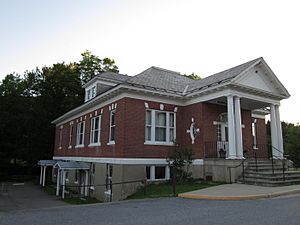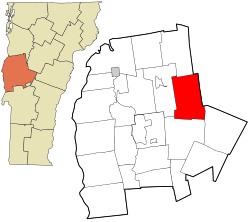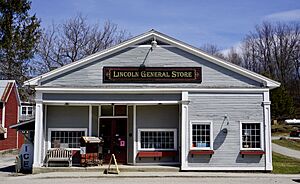Lincoln, Vermont facts for kids
Quick facts for kids
Lincoln, Vermont
|
||
|---|---|---|
 |
||
|
||

Location in Addison County and the state of Vermont.
|
||
| Country | United States | |
| State | Vermont | |
| County | Addison | |
| Chartered | 1780 | |
| Settled | 1790 | |
| Organized | 1798 | |
| Communities | Lincoln Downingville South Lincoln West Lincoln |
|
| Area | ||
| • Total | 44.6 sq mi (115.5 km2) | |
| • Land | 44.4 sq mi (115.0 km2) | |
| • Water | 0.2 sq mi (0.5 km2) | |
| Elevation | 1,263 ft (385 m) | |
| Population
(2020)
|
||
| • Total | 1,323 | |
| • Density | 30/sq mi (11.5/km2) | |
| Time zone | UTC-5 (Eastern (EST)) | |
| • Summer (DST) | UTC-4 (EDT) | |
| ZIP code |
05443
|
|
| Area code | 802 | |
| FIPS code | 50-40075 | |
| GNIS feature ID | 1462135 | |
Lincoln is a small town in Addison County, Vermont, United States. It sits at the base of Mount Abraham, which is part of the Green Mountains. The town was first settled by a group called Quakers in the late 1700s. In 2020, about 1,323 people lived there. Lincoln is known for its beautiful countryside. It is also close to two popular Vermont ski resorts: Mad River Glen and Sugarbush.
Contents
Where is Lincoln, Vermont?
Lincoln is located in the northeastern part of Addison County. It is nestled within the Green Mountains. A famous hiking path called the Long Trail runs along the mountain peaks near the town's eastern edge. The highest point in town is Mount Abraham, which is about 4,006 feet tall. The lowest point is near West Lincoln, at 840 feet above sea level. This is where the New Haven River flows out of town.
How to Get Around Lincoln
The Lincoln Gap Road crosses the Green Mountains at a spot called Lincoln Gap. This road connects the main part of Lincoln to the town of Warren in the east. However, this road is only open during the summer months. Most people get to Lincoln by traveling through the nearby town of Bristol. You won't find any major state highways running through Lincoln itself.
The United States Census Bureau says that Lincoln covers an area of about 44.6 square miles (115.5 square kilometers). Most of this area is land, with only a small amount of water.
A Look at Lincoln's History
Lincoln was officially created on November 9, 1780. It was named after Major General Benjamin Lincoln. He was a respected military leader during the American Revolutionary War.
Who Settled Lincoln?
Like some other towns in Addison County, Lincoln was settled by members of the Society of Friends, also known as Quakers. The first Quakers arrived around 1795 in an area called Mud Flat. As more Quakers moved in, the area became known as Quaker Stand. Even though the original meeting house is gone, a part of Lincoln village is still called Quaker Street today. The town government officially started in 1798. The first town meeting was held in a log cabin belonging to an early settler named Jedediah Durfee.
What Was Lincoln's Economy Like?
For a long time, Lincoln's economy relied on small farms, ironworks, and mills. Early settlers sold products like potash and timber after clearing their land. The town grew the most in the 1880s. At that time, there were 15 lumber mills in town. These mills made things like shingles and clapboard and employed about 100 men. Dairy farms and potato farming were also very important to the town's economy.
Lincoln also grew to include smaller communities like Downingsville, West Lincoln, South Lincoln, and Center Lincoln. The town has faced destructive floods from the New Haven River many times, including in 1830, 1869, 1938, 1976, and 1998.
The Burnham Trust
In 1919, a businessman named Walter S. Burnham, who was born in Lincoln, left a large amount of money to the town in his will. This money created the Burnham Trust. The Trust was meant to support "educational, charitable, and musical purposes." It helped build Burnham Hall, which is a community meeting place and used to be the town library. The Trust also created a scholarship fund to help Lincoln students go to college. Burnham Hall is still where Lincoln's town meetings are held today.
Changes in the 20th Century
In the middle of the 1900s, Lincoln's population and economy shrank. The jobs based on natural resources became less common, and families moved away. Smaller dairy farms found it hard to compete with bigger farms elsewhere. Lincoln's last dairy farm closed in 1992. Most of the mills also closed by the end of the century, though one mill that makes wooden pallets is still open. In 1968, Lincoln even lost its own post office. Mail services were moved to Bristol.
Lincoln Today
In the 21st century, Lincoln's population has grown again. It is almost back to its highest point. People are drawn to Lincoln because it is close to the Green Mountains, it is a peaceful place, and it has good community services. Most adults who work commute to jobs in nearby towns. However, Lincoln still has a general store, a hotel, and several small businesses that make maple syrup. Some larger syrup producers are also in the area, with one tapping as many as 35,000 trees.
On September 11, 2010, the first Tibetan Buddhist nunnery in North America was opened in Lincoln.
Community Life in Lincoln
Lincoln has a community church called the United Church of Lincoln. It is located in the center of town at the bottom of Quaker Street. The Lincoln General Store is a very important place for the community. Since there is no post office or gas station in town, the general store acts as a central gathering spot for residents.
Notable People from Lincoln
Many interesting people have connections to Lincoln:
- Chris Bohjalian, a well-known author, lives in Lincoln.
- Frederick Howard Bryant, who became a federal judge, was born in Lincoln.
- Abram Hatch, a leader in the Mormon church and a government official in Utah, was also born here.
- William Eldridge Odom, a U.S. Army lieutenant general, had a vacation home in Lincoln.
- Elizabeth M. Ready, who served in the Vermont Senate and as the Vermont Auditor of Accounts, lives in Lincoln.
- Ronald Rood, a naturalist, author, and radio commentator, lived in Lincoln.
- Roger Shattuck, an author and scholar, also lived in Lincoln.
See also
 In Spanish: Lincoln (Vermont) para niños
In Spanish: Lincoln (Vermont) para niños




